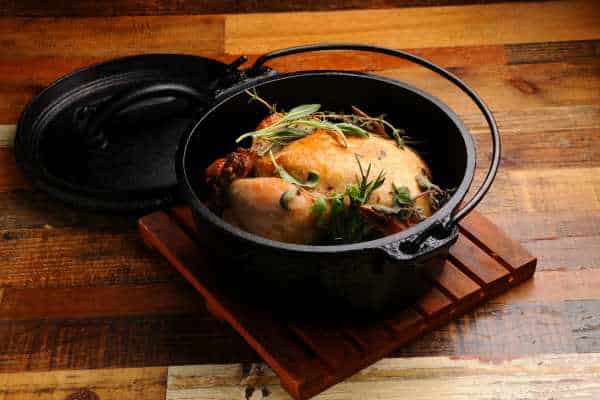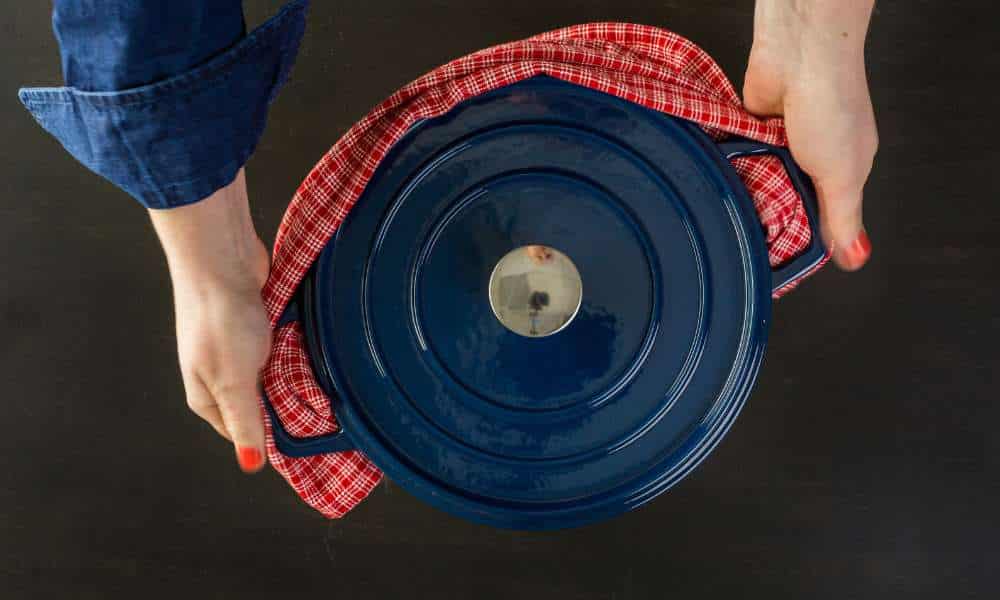Welcome to the ultimate guide on “How to Clean Cast Iron Dutch Oven.” Whether you’re a culinary expert or a kitchen novice, maintaining the pristine condition of your cast iron Dutch oven is crucial for its performance and longevity. This article will provide you with essential tips and techniques to effectively clean your cookware without damaging its seasoned surface. We’ll cover everything from routine cleaning after each use to addressing those stubborn stains and residues. By adhering to these guidelines, you can ensure your Dutch oven remains a reliable companion in your culinary adventures, ready to deliver delicious meals every time. Let’s get started on the path to keeping your Dutch oven in perfect shape!
Understanding the Importance of Proper Cleaning

Proper cleaning of your cast iron Dutch oven is not just about aesthetics; it directly impacts the cookware’s functionality and durability. Regular and correct maintenance prevents rust, preserves the essential seasoning, and ensures optimal cooking results. Neglecting this can lead to the buildup of bacteria and stubborn stains that degrade the iron and its cooking properties. By embracing the right cleaning techniques, you protect your investment and ensure that your Dutch oven continues to provide superior heat retention and flavor enhancement in all your dishes, making it a cherished tool in your kitchen arsenal for years to come.
Preparing Your Cast Iron Dutch Oven for Cleaning
Before tackling the cleaning of your cast iron Dutch oven, it’s crucial to prepare it properly to ensure a safe and effective cleaning process. Start by allowing the cookware to cool completely to avoid thermal shock. Next, remove any loose food particles by wiping the interior with a paper towel or a soft brush. This preliminary step helps prevent scratching the surface during the wash. For cookware with tough residue, consider simmering some water in it on the stove for a few minutes to help loosen the stuck-on bits, making them easier to remove. Proper preparation simplifies the cleaning process and helps maintain the integrity of your Dutch oven.
The Do’s and Don’ts of Cleaning Cast Iron

Maintaining a cast iron Dutch oven requires knowing what to do and what to avoid. Always gently scrub your cookware using a non-metal brush or sponge with warm water; harsh soaps can strip away the seasoning. For tough residues, a paste of coarse salt and water can be effective. Never soak the pan, as prolonged exposure to water can lead to rust. After washing, dry it thoroughly and apply a light coat of oil to protect the surface. These simple but crucial steps will help preserve the integrity of your cast iron, ensuring it continues to produce the best culinary results.
Step-by-Step Guide to Cleaning After Cooking
After cooking with your clean a cast iron Dutch oven, promptly cleaning it ensures it remains in great condition. Start by wiping out any leftover food with a paper towel. Rinse the oven with warm water and use a non-metal brush or sponge to gently scrub off any residues. Avoid using soap and harsh detergents as they can strip the seasoning. If needed, boil some water in the pot to loosen tough bits. Dry the Dutch oven thoroughly with a clean cloth or on a warm stove to prevent rust. Finally, apply a light coat of cooking oil to protect the surface until its next use. This routine helps maintain the non-stick qualities and extends the life of your cookware.
How to Remove Stuck-On Food from Your Dutch Oven

Removing stuck-on food from your cast iron Dutch oven can seem daunting, but it’s a straightforward process. Start by filling the oven with water and bringing it to a simmer on the stove. This gentle heat helps loosen the food particles without damaging the seasoned surface. After a few minutes, use a wooden spatula or brush to scrape away the residue. For tougher spots, a paste of coarse salt and water can be used as a gentle abrasive. Once the debris is removed, rinse the Dutch oven with warm water, dry it thoroughly, and apply a light coat of oil to protect the seasoning. This method ensures your cookware stays clean and functional.
Techniques for Deep Cleaning Cast Iron
Deep cleaning your cast iron Dutch oven is essential for maintaining its optimal performance. Start by warming the pot slightly to loosen any residue. Then, create a paste with coarse kosher salt and water, and use this mixture to scrub the interior gently with a non-metal brush or sponge. This abrasive solution helps remove tough stains without compromising the seasoning. For extremely stubborn residues, simmering a little water in the pot for a few minutes can also be effective. After scrubbing, rinse thoroughly with warm water, dry completely, and apply a light coating of oil to protect the surface. This method ensures your cast iron remains in excellent condition.
Drying and Storing Your Cast Iron Dutch Oven

Proper drying and storage are key to maintaining your cast iron Dutch oven. After washing, thoroughly dry your oven with a clean towel to prevent rust. It’s crucial to avoid leaving any moisture on the surface. Once dry, apply a light coat of cooking oil to protect the seasoning. Store your Dutch oven in a dry place with the lid off or slightly ajar to promote air circulation and prevent moisture buildup. This method not only extends the life of your Dutch oven but also ensures it’s ready for your next cooking adventure without any additional prep work.
Seasoning Your Dutch Oven Post-Cleaning
After thoroughly cleaning your cast iron Dutch oven, it’s crucial to season it to maintain its non-stick properties and prevent rust. Start by drying it completely over low heat on your stove to eliminate any moisture. Once dry, coat the interior and exterior surfaces lightly with a high-smoke point oil, like flaxseed or canola. Place the Dutch oven in a preheated oven at 450 degrees Fahrenheit, upside down, for an hour. This process will bake the oil into the surface, creating a protective layer. Let it cool in the oven. This re-seasoning should be done periodically to preserve your cookware’s functionality and enhance your cooking results.
Preventative Measures to Keep Your Dutch Oven Clean

To keep your cast iron Dutch oven in top condition, preventative measures are key. Always apply a light coat of oil after cleaning to protect the surface from moisture and rust. When cooking, use wooden or silicone utensils to prevent scratches on the seasoned surface. Avoid leaving water in the pot for prolonged periods, as this can lead to rusting. Additionally, consider using parchment paper or aluminum foil when baking sticky or sugary foods to minimize mess. By implementing these simple habits, you can extend the life of your Dutch oven, ensuring it remains a cherished tool in your kitchen arsenal for years to come.
Troubleshooting Common Cleaning Issues
When cleaning your cast iron Dutch oven, you might encounter a few common issues such as rust formation or stubborn food residues. To tackle rust, use a mixture of baking soda and water to create a paste, then scrub gently with a non-metal brush. For tough food remnants, boil a small amount of water in the pot, letting the steam loosen the debris before scrubbing it away. Always dry your Dutch oven thoroughly after washing to prevent rust, and apply a light coat of oil to preserve the seasoning. These simple steps will help you maintain the integrity and functionality of your cookware for years to come.
Conclusion
Mastering how to clean a cast iron Dutch oven is crucial for preserving its quality and enhancing your cooking experience. By following the proper cleaning techniques discussed in this guide, you can ensure that your Dutch oven remains in excellent condition, free from rust and buildup. Regular care not only prolongs the life of your cookware but also improves its non-stick properties, making cooking and cleanup easier. Remember, a well-maintained cast iron Dutch oven is an invaluable tool in your culinary arsenal, ready to produce flavorful dishes that delight your family and friends. Treat it well, and it will serve you faithfully for many years.

